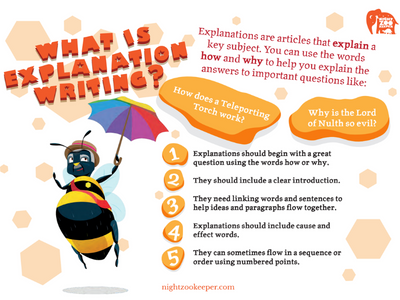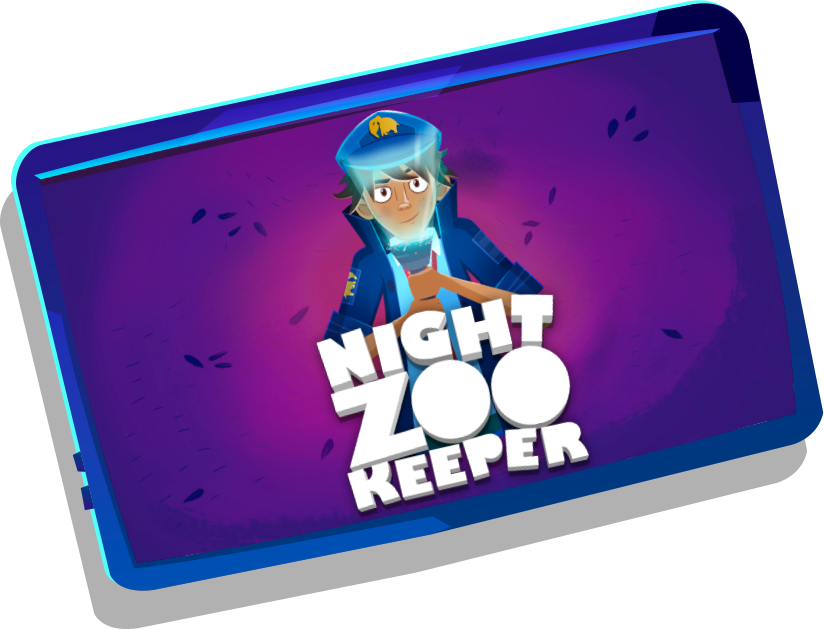Explanation Writing
Free explanation writing guide & worksheets

Home > Worksheets > Writing Styles > Explanation Writing
One of the most valuable writing skills a child can learn is the ability to explain themselves. Through learning about explanation writing, your child will improve their critical thinking and explanatory skills, and their understanding of both factual and opinion writing.
Let’s get into what explanation writing is, what the features of an explanation text are, and how you can help your child improve their explanation writing skills!

What is explanation writing?
Explanatory texts (also known as expository texts) answer a question and/or explain a subject, action, or event. They are primarily informational texts. Types of explanation texts include:
- Causal explanations
- Step-by-step & “How to” guides
- Procedural writing
Step-by-step and “how to” guides are a specific type of explanation: instruction texts. We cover instruction texts in a separate guide.
How to write an explanation text
A great explanation solves a question or problem a reader is facing by providing them with actionable steps they can follow seamlessly. Here are seven simple steps to writing a great explanation text:
- Start with a question including how or why.
- Think of the main points you want to highlight in order to effectively answer the question. These might become your subheadings.
- Have a clear introduction explaining the topic.
- Write in the present tense and use action verbs.
- Use linking words & phrases to help your writing feel cohesive when moving between ideas.
- Use cause and effect words to explain your topic thoroughly.
- Consider using numbered points, pictures, or diagrams to help your readers understand each point even better and emphasize the context of your explanation text throughout.
Explanation texts often include several linguistic features, such as:
- Written in the present tense
- Time connectives
- Sequencing
- Subheadings
- Linking phrases
- Clear sentence structure
- Technical terminology
Formal language
When writing an explanation, using formal language makes it clearer and more informative. Formal language helps express ideas accurately, so readers understand the points. Explanation writing often uses technical terms, like “condensation” in an essay about the water cycle. These terms sometimes need to be explained early on, so they can be used without confusing the reader.
Linking words & phrases
Linking words and phrases can help make explanation writing cohesive and clear by connecting ideas and giving a sense of progress. There are different types, such as time connectives, cause and effect words, and for additional information. Here are some examples:
Time Connectives
- Firstly
- Secondly
- Lastly
- Finally
Cause and effect
- Therefore
- In conclusion
- Moreover
- As a result of
For additional information
- Additionally
- Furthermore
- Likewise
- Similarly
Action verbs
Action verbs add energy and clarity to a piece of writing, helping readers vividly imagine what's happening. When explaining things, whether that’s how to tie their shoelaces, or how to bake the perfect chocolate cake, choosing action verbs makes it easier for the audience to understand exactly what to do!
Example Explanation Text
How is honey made?
Firstly, bees collect nectar from flowers with their mouths which are shaped like tubes.
They then transport the sweet nectar to their hive.
The bees continue to fly back and forth hundreds of times between flowers and their hives delivering the nectar.
Each time they return to their hive, they pass on the nectar to the “house bees”.
House bees now have the special job of making the honey. It is passed mouth to mouth between the house bees until the liquid becomes thicker.
The thick liquid is then stored in the hexagonal honeycombs and sealed with beeswax.
A beekeeper, wearing protective clothing, will regularly gather the honeycomb and remove the honey.
Honey is finally packed and prepared by farms and factories to send on to the stores where people can buy it.
Topics for explanation texts
Challenge your child to write about one of these topics:
- How does the recycling process work?
- Why do volcanoes erupt?
- How can you be a good friend?
- Why does it get cold at night?
- How do you make a peanut butter and jelly sandwich?
- Why should we eat fruits and vegetables?
- How often should you walk a dog?
- Why do we need sleep?
- How do you ride a bicycle?
Free Explanation Writing worksheets
We have assembled a series of explanation writing worksheets to help your child practice their skills. You can download them for free.

How Night Zookeeper can help

Night Zookeeper makes learning to read and write fun through thousands of activities, including word games, skill challenges and interactive lessons covering sentence structure, language features, and more! Our reading & writing program is a great way to help your child develop their understanding of different styles of writing.
More writing styles
Writing resources & activities


Make Reading & Writing Fantastically Fun!
- Award-winning reading & writing program for kids
- Improves spelling, grammar, punctuation & vocabulary
- Over 1,000 different learning games and activities



